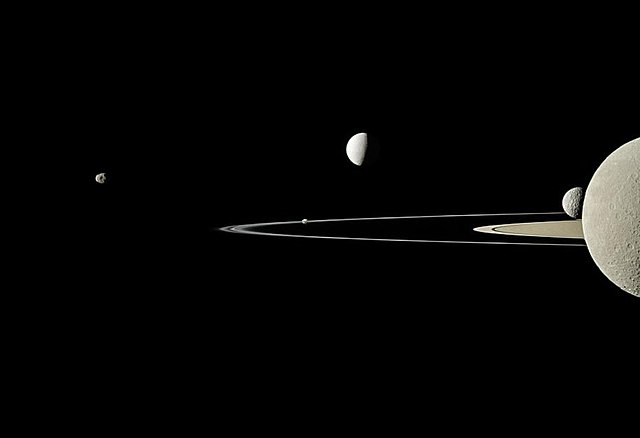Titan is the largest moon of Saturn and the second-largest in the Solar System. It is the only moon known to have an atmosphere denser than the Earth's, and is the only known object in space other than Earth on which clear evidence of stable bodies of surface liquid has been found. Titan is one of the seven gravitationally rounded moons of Saturn and the second-most distant among them. Frequently described as a planet-like moon, Titan is 50% larger than Earth's Moon and 80% more massive. It is the second-largest moon in the Solar System after Jupiter's moon Ganymede, and is larger than Mercury, but only 40% as massive due to Mercury being made of mostly dense iron and rock, while a large portion of Titan is made of less-dense ice.
Titan, imaged by the Cassini orbiter, December 2011. A thick shroud of organic haze permanently obscures Titan's surface from viewing in visible light
Christiaan Huygens discovered Titan in 1655.
Size comparison: Titan (lower left) with the Moon and Earth (top and right)
Polar clouds, made of methane, on Titan (left) compared with polar clouds on Earth (right), which are made of water or water ice.
The moons of Saturn are numerous and diverse, ranging from tiny moonlets only tens of meters across to the enormous Titan, which is larger than the planet Mercury. There are 146 moons with confirmed orbits, the most of any planet in the solar system. This number does not include the many thousands of moonlets embedded within Saturn's dense rings, nor hundreds of possible kilometer-sized distant moons that were seen through telescopes but not recaptured. Seven Saturnian moons are large enough to have collapsed into a relaxed, ellipsoidal shape, though only one or two of those, Titan and possibly Rhea, are currently in hydrostatic equilibrium. Three moons are particularly notable. Titan is the second-largest moon in the Solar System, with a nitrogen-rich Earth-like atmosphere and a landscape featuring river networks and hydrocarbon lakes. Enceladus emits jets of ice from its south-polar region and is covered in a deep layer of snow. Iapetus has contrasting black and white hemispheres as well as an extensive ridge of equatorial mountains among the tallest in the solar system.

An annotated picture of Saturn's many moons captured by the Cassini spacecraft. Shown in the image are Dione, Enceladus, Epimetheus, Prometheus, Mimas, Rhea, Janus, Tethys and Titan.
Saturn (overexposed) and the moons Iapetus, Titan, Dione, Hyperion, and Rhea viewed through a 12.5-inch telescope
Five moons in a Cassini image: Rhea bisected in the far-right foreground, Mimas behind it, bright Enceladus above and beyond the rings, Pandora eclipsed by the F Ring, and Janus off to the left
Quadruple Saturn–moon transit captured by the Hubble Space Telescope








